Barriers to Infection Prevention in Nursing Homes: A Report
VerifiedAdded on 2023/06/04
|6
|2419
|458
Report
AI Summary
This report analyzes a qualitative study by Travers et al. (2015) investigating the perceived barriers to infection prevention and control for certified nursing assistants (CNAs) in nursing homes. The study, conducted through audio-recorded interviews across various nursing homes, identified key barriers including language/culture differences, inadequate knowledge/training, use of per-diem staff, heavy workloads, and lack of accountability. The researchers interviewed various staff members, including CNAs, infection preventionists, and administrators. The findings underscore the need for targeted strategies to address these barriers, such as empowering CNAs, increasing staffing levels, providing hands-on training, addressing the needs of part-time staff, and translating in-service materials. The study highlights the impact of these barriers on the implementation of infection control practices and suggests recommendations for improvement, emphasizing the need for culturally sensitive training and clear communication to improve patient safety and reduce healthcare-associated infections. The report concludes with a discussion of the ethical considerations observed during the study and provides relevant references.
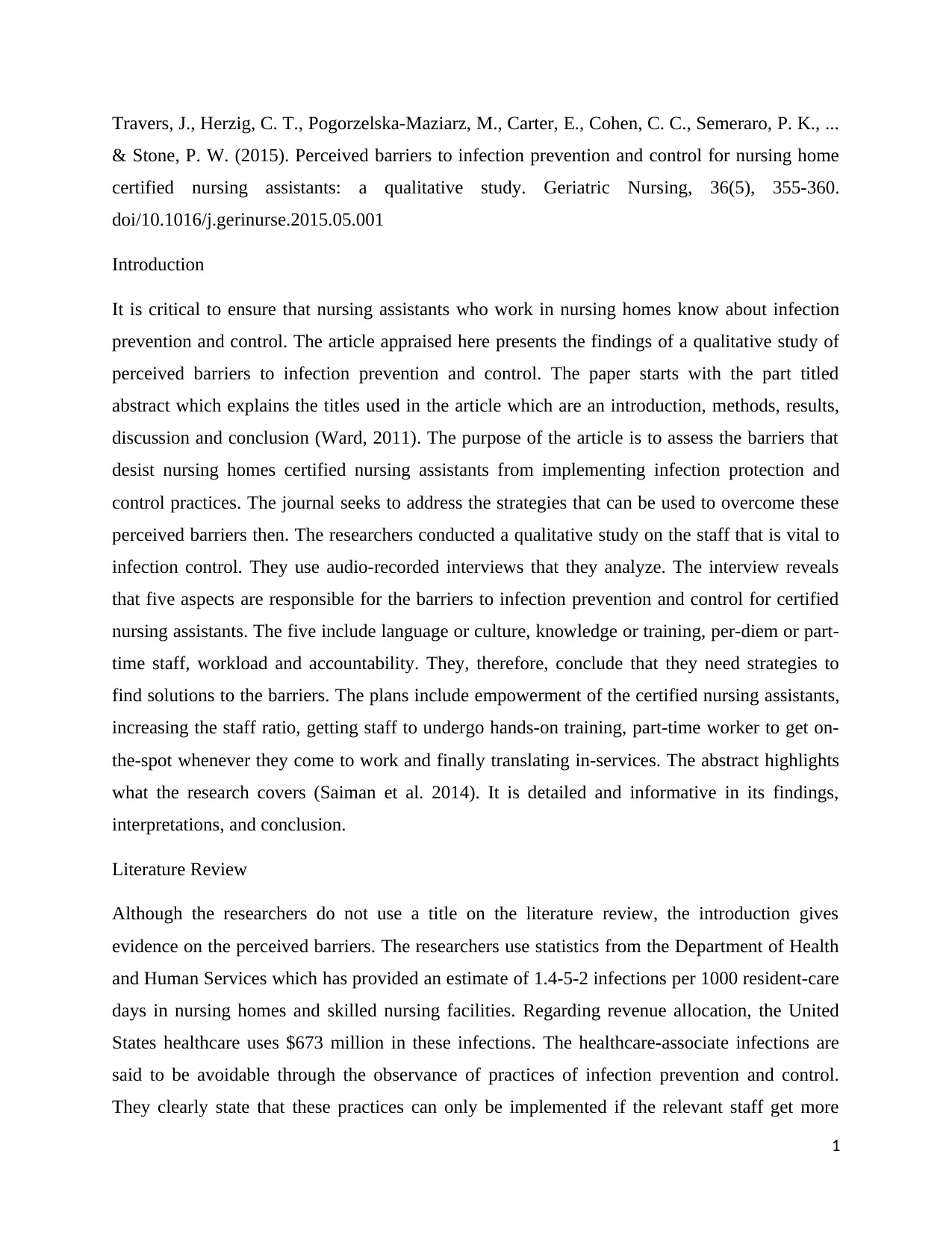
Travers, J., Herzig, C. T., Pogorzelska-Maziarz, M., Carter, E., Cohen, C. C., Semeraro, P. K., ...
& Stone, P. W. (2015). Perceived barriers to infection prevention and control for nursing home
certified nursing assistants: a qualitative study. Geriatric Nursing, 36(5), 355-360.
doi/10.1016/j.gerinurse.2015.05.001
Introduction
It is critical to ensure that nursing assistants who work in nursing homes know about infection
prevention and control. The article appraised here presents the findings of a qualitative study of
perceived barriers to infection prevention and control. The paper starts with the part titled
abstract which explains the titles used in the article which are an introduction, methods, results,
discussion and conclusion (Ward, 2011). The purpose of the article is to assess the barriers that
desist nursing homes certified nursing assistants from implementing infection protection and
control practices. The journal seeks to address the strategies that can be used to overcome these
perceived barriers then. The researchers conducted a qualitative study on the staff that is vital to
infection control. They use audio-recorded interviews that they analyze. The interview reveals
that five aspects are responsible for the barriers to infection prevention and control for certified
nursing assistants. The five include language or culture, knowledge or training, per-diem or part-
time staff, workload and accountability. They, therefore, conclude that they need strategies to
find solutions to the barriers. The plans include empowerment of the certified nursing assistants,
increasing the staff ratio, getting staff to undergo hands-on training, part-time worker to get on-
the-spot whenever they come to work and finally translating in-services. The abstract highlights
what the research covers (Saiman et al. 2014). It is detailed and informative in its findings,
interpretations, and conclusion.
Literature Review
Although the researchers do not use a title on the literature review, the introduction gives
evidence on the perceived barriers. The researchers use statistics from the Department of Health
and Human Services which has provided an estimate of 1.4-5-2 infections per 1000 resident-care
days in nursing homes and skilled nursing facilities. Regarding revenue allocation, the United
States healthcare uses $673 million in these infections. The healthcare-associate infections are
said to be avoidable through the observance of practices of infection prevention and control.
They clearly state that these practices can only be implemented if the relevant staff get more
1
& Stone, P. W. (2015). Perceived barriers to infection prevention and control for nursing home
certified nursing assistants: a qualitative study. Geriatric Nursing, 36(5), 355-360.
doi/10.1016/j.gerinurse.2015.05.001
Introduction
It is critical to ensure that nursing assistants who work in nursing homes know about infection
prevention and control. The article appraised here presents the findings of a qualitative study of
perceived barriers to infection prevention and control. The paper starts with the part titled
abstract which explains the titles used in the article which are an introduction, methods, results,
discussion and conclusion (Ward, 2011). The purpose of the article is to assess the barriers that
desist nursing homes certified nursing assistants from implementing infection protection and
control practices. The journal seeks to address the strategies that can be used to overcome these
perceived barriers then. The researchers conducted a qualitative study on the staff that is vital to
infection control. They use audio-recorded interviews that they analyze. The interview reveals
that five aspects are responsible for the barriers to infection prevention and control for certified
nursing assistants. The five include language or culture, knowledge or training, per-diem or part-
time staff, workload and accountability. They, therefore, conclude that they need strategies to
find solutions to the barriers. The plans include empowerment of the certified nursing assistants,
increasing the staff ratio, getting staff to undergo hands-on training, part-time worker to get on-
the-spot whenever they come to work and finally translating in-services. The abstract highlights
what the research covers (Saiman et al. 2014). It is detailed and informative in its findings,
interpretations, and conclusion.
Literature Review
Although the researchers do not use a title on the literature review, the introduction gives
evidence on the perceived barriers. The researchers use statistics from the Department of Health
and Human Services which has provided an estimate of 1.4-5-2 infections per 1000 resident-care
days in nursing homes and skilled nursing facilities. Regarding revenue allocation, the United
States healthcare uses $673 million in these infections. The healthcare-associate infections are
said to be avoidable through the observance of practices of infection prevention and control.
They clearly state that these practices can only be implemented if the relevant staff get more
1
Paraphrase This Document
Need a fresh take? Get an instant paraphrase of this document with our AI Paraphraser
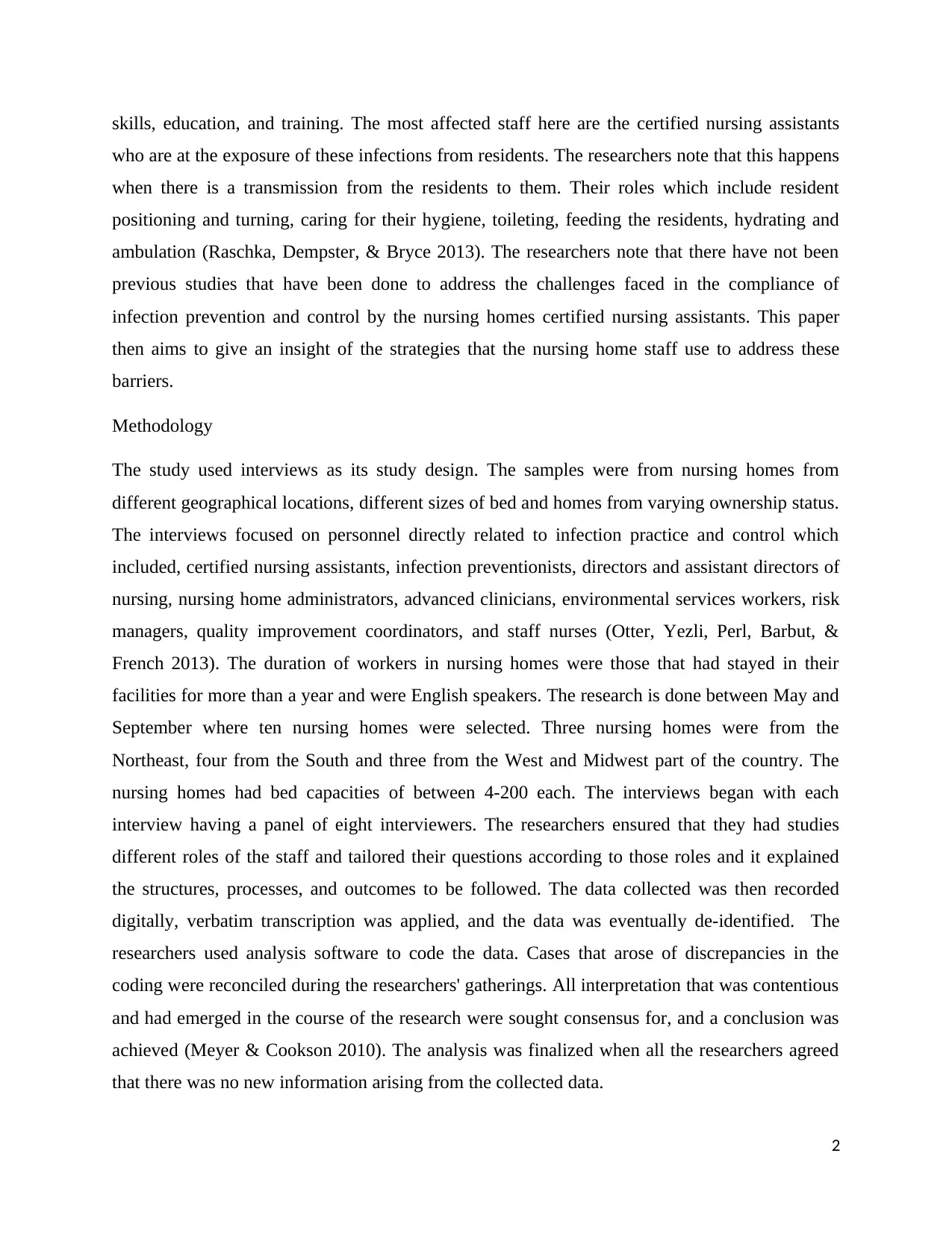
skills, education, and training. The most affected staff here are the certified nursing assistants
who are at the exposure of these infections from residents. The researchers note that this happens
when there is a transmission from the residents to them. Their roles which include resident
positioning and turning, caring for their hygiene, toileting, feeding the residents, hydrating and
ambulation (Raschka, Dempster, & Bryce 2013). The researchers note that there have not been
previous studies that have been done to address the challenges faced in the compliance of
infection prevention and control by the nursing homes certified nursing assistants. This paper
then aims to give an insight of the strategies that the nursing home staff use to address these
barriers.
Methodology
The study used interviews as its study design. The samples were from nursing homes from
different geographical locations, different sizes of bed and homes from varying ownership status.
The interviews focused on personnel directly related to infection practice and control which
included, certified nursing assistants, infection preventionists, directors and assistant directors of
nursing, nursing home administrators, advanced clinicians, environmental services workers, risk
managers, quality improvement coordinators, and staff nurses (Otter, Yezli, Perl, Barbut, &
French 2013). The duration of workers in nursing homes were those that had stayed in their
facilities for more than a year and were English speakers. The research is done between May and
September where ten nursing homes were selected. Three nursing homes were from the
Northeast, four from the South and three from the West and Midwest part of the country. The
nursing homes had bed capacities of between 4-200 each. The interviews began with each
interview having a panel of eight interviewers. The researchers ensured that they had studies
different roles of the staff and tailored their questions according to those roles and it explained
the structures, processes, and outcomes to be followed. The data collected was then recorded
digitally, verbatim transcription was applied, and the data was eventually de-identified. The
researchers used analysis software to code the data. Cases that arose of discrepancies in the
coding were reconciled during the researchers' gatherings. All interpretation that was contentious
and had emerged in the course of the research were sought consensus for, and a conclusion was
achieved (Meyer & Cookson 2010). The analysis was finalized when all the researchers agreed
that there was no new information arising from the collected data.
2
who are at the exposure of these infections from residents. The researchers note that this happens
when there is a transmission from the residents to them. Their roles which include resident
positioning and turning, caring for their hygiene, toileting, feeding the residents, hydrating and
ambulation (Raschka, Dempster, & Bryce 2013). The researchers note that there have not been
previous studies that have been done to address the challenges faced in the compliance of
infection prevention and control by the nursing homes certified nursing assistants. This paper
then aims to give an insight of the strategies that the nursing home staff use to address these
barriers.
Methodology
The study used interviews as its study design. The samples were from nursing homes from
different geographical locations, different sizes of bed and homes from varying ownership status.
The interviews focused on personnel directly related to infection practice and control which
included, certified nursing assistants, infection preventionists, directors and assistant directors of
nursing, nursing home administrators, advanced clinicians, environmental services workers, risk
managers, quality improvement coordinators, and staff nurses (Otter, Yezli, Perl, Barbut, &
French 2013). The duration of workers in nursing homes were those that had stayed in their
facilities for more than a year and were English speakers. The research is done between May and
September where ten nursing homes were selected. Three nursing homes were from the
Northeast, four from the South and three from the West and Midwest part of the country. The
nursing homes had bed capacities of between 4-200 each. The interviews began with each
interview having a panel of eight interviewers. The researchers ensured that they had studies
different roles of the staff and tailored their questions according to those roles and it explained
the structures, processes, and outcomes to be followed. The data collected was then recorded
digitally, verbatim transcription was applied, and the data was eventually de-identified. The
researchers used analysis software to code the data. Cases that arose of discrepancies in the
coding were reconciled during the researchers' gatherings. All interpretation that was contentious
and had emerged in the course of the research were sought consensus for, and a conclusion was
achieved (Meyer & Cookson 2010). The analysis was finalized when all the researchers agreed
that there was no new information arising from the collected data.
2
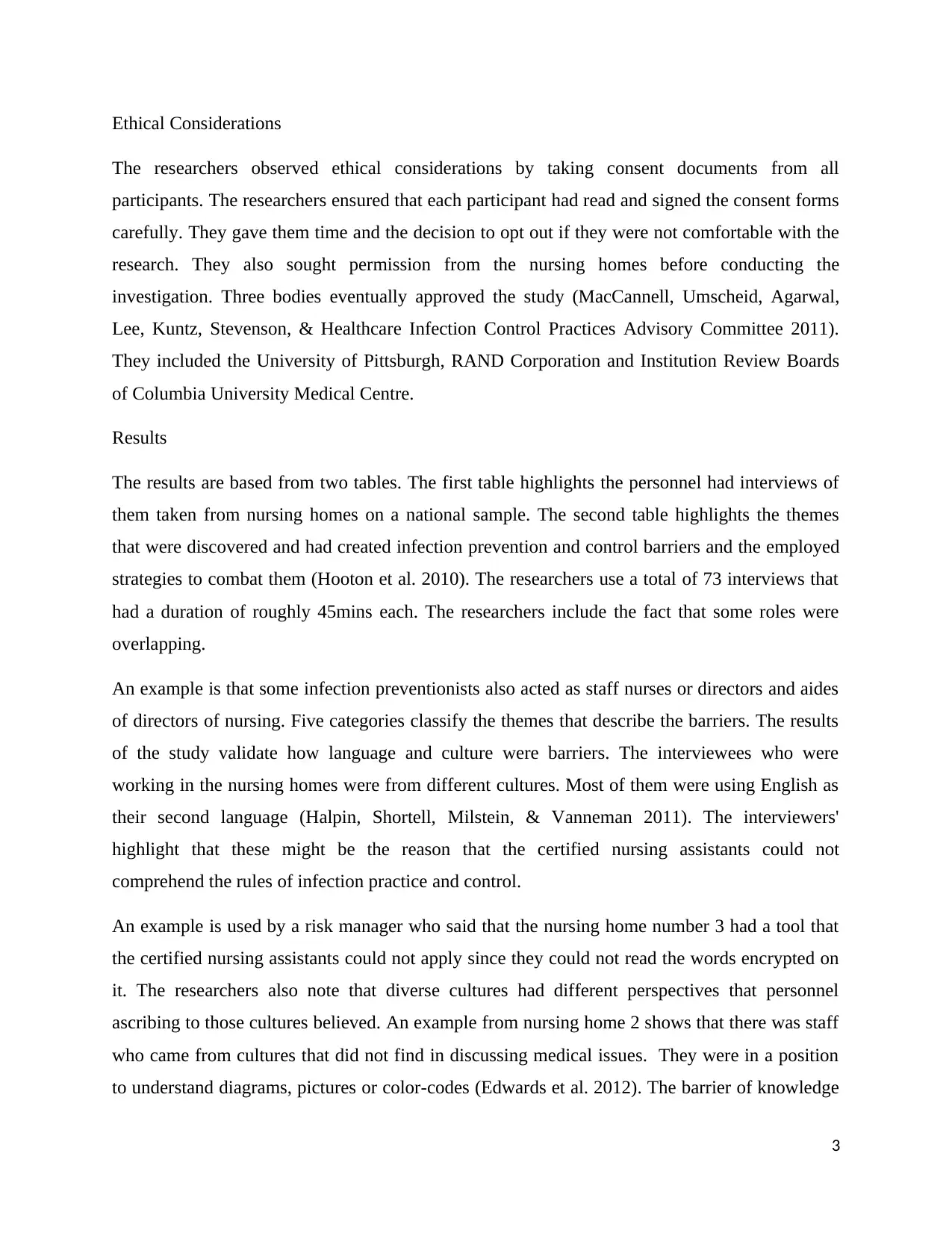
Ethical Considerations
The researchers observed ethical considerations by taking consent documents from all
participants. The researchers ensured that each participant had read and signed the consent forms
carefully. They gave them time and the decision to opt out if they were not comfortable with the
research. They also sought permission from the nursing homes before conducting the
investigation. Three bodies eventually approved the study (MacCannell, Umscheid, Agarwal,
Lee, Kuntz, Stevenson, & Healthcare Infection Control Practices Advisory Committee 2011).
They included the University of Pittsburgh, RAND Corporation and Institution Review Boards
of Columbia University Medical Centre.
Results
The results are based from two tables. The first table highlights the personnel had interviews of
them taken from nursing homes on a national sample. The second table highlights the themes
that were discovered and had created infection prevention and control barriers and the employed
strategies to combat them (Hooton et al. 2010). The researchers use a total of 73 interviews that
had a duration of roughly 45mins each. The researchers include the fact that some roles were
overlapping.
An example is that some infection preventionists also acted as staff nurses or directors and aides
of directors of nursing. Five categories classify the themes that describe the barriers. The results
of the study validate how language and culture were barriers. The interviewees who were
working in the nursing homes were from different cultures. Most of them were using English as
their second language (Halpin, Shortell, Milstein, & Vanneman 2011). The interviewers'
highlight that these might be the reason that the certified nursing assistants could not
comprehend the rules of infection practice and control.
An example is used by a risk manager who said that the nursing home number 3 had a tool that
the certified nursing assistants could not apply since they could not read the words encrypted on
it. The researchers also note that diverse cultures had different perspectives that personnel
ascribing to those cultures believed. An example from nursing home 2 shows that there was staff
who came from cultures that did not find in discussing medical issues. They were in a position
to understand diagrams, pictures or color-codes (Edwards et al. 2012). The barrier of knowledge
3
The researchers observed ethical considerations by taking consent documents from all
participants. The researchers ensured that each participant had read and signed the consent forms
carefully. They gave them time and the decision to opt out if they were not comfortable with the
research. They also sought permission from the nursing homes before conducting the
investigation. Three bodies eventually approved the study (MacCannell, Umscheid, Agarwal,
Lee, Kuntz, Stevenson, & Healthcare Infection Control Practices Advisory Committee 2011).
They included the University of Pittsburgh, RAND Corporation and Institution Review Boards
of Columbia University Medical Centre.
Results
The results are based from two tables. The first table highlights the personnel had interviews of
them taken from nursing homes on a national sample. The second table highlights the themes
that were discovered and had created infection prevention and control barriers and the employed
strategies to combat them (Hooton et al. 2010). The researchers use a total of 73 interviews that
had a duration of roughly 45mins each. The researchers include the fact that some roles were
overlapping.
An example is that some infection preventionists also acted as staff nurses or directors and aides
of directors of nursing. Five categories classify the themes that describe the barriers. The results
of the study validate how language and culture were barriers. The interviewees who were
working in the nursing homes were from different cultures. Most of them were using English as
their second language (Halpin, Shortell, Milstein, & Vanneman 2011). The interviewers'
highlight that these might be the reason that the certified nursing assistants could not
comprehend the rules of infection practice and control.
An example is used by a risk manager who said that the nursing home number 3 had a tool that
the certified nursing assistants could not apply since they could not read the words encrypted on
it. The researchers also note that diverse cultures had different perspectives that personnel
ascribing to those cultures believed. An example from nursing home 2 shows that there was staff
who came from cultures that did not find in discussing medical issues. They were in a position
to understand diagrams, pictures or color-codes (Edwards et al. 2012). The barrier of knowledge
3
⊘ This is a preview!⊘
Do you want full access?
Subscribe today to unlock all pages.

Trusted by 1+ million students worldwide
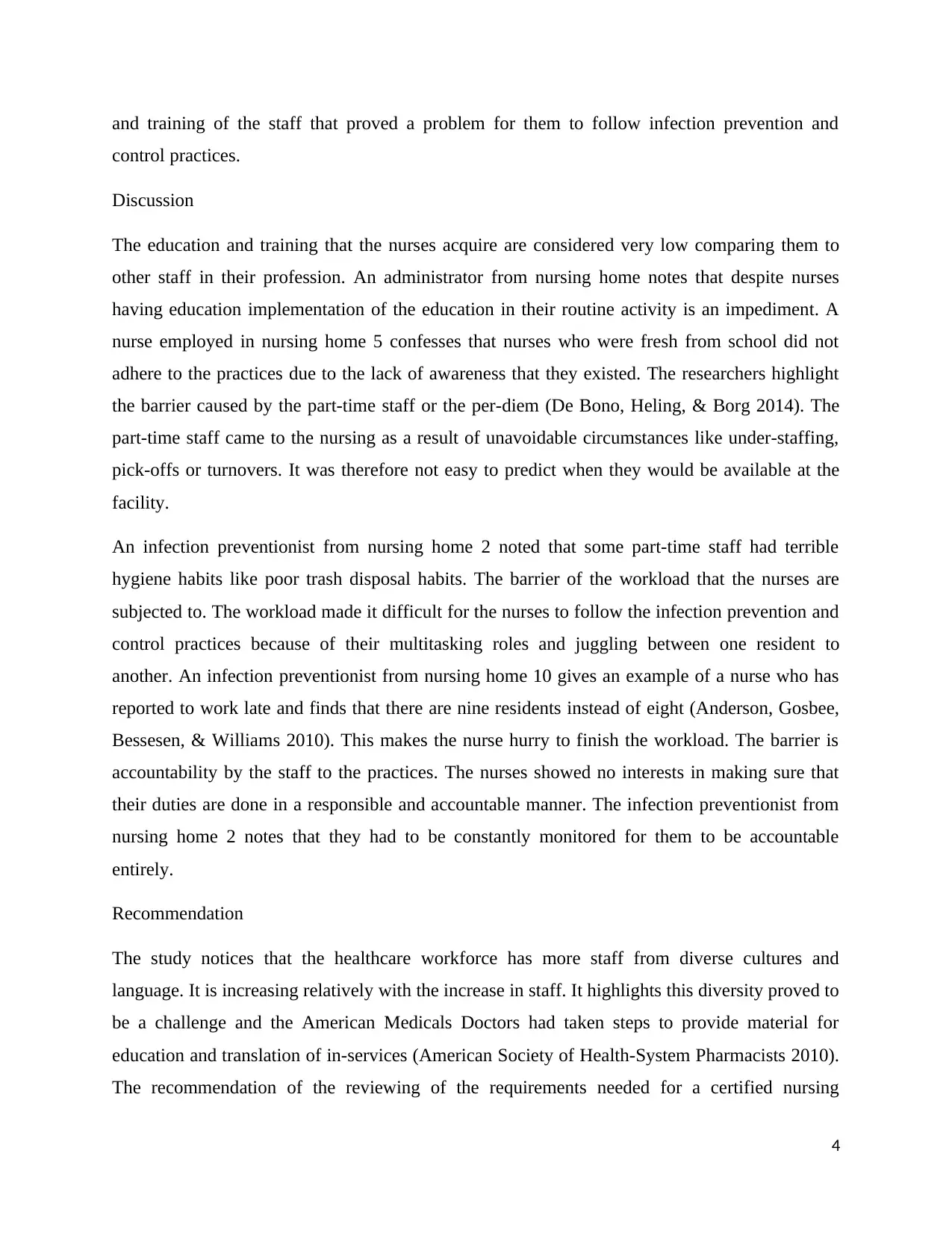
and training of the staff that proved a problem for them to follow infection prevention and
control practices.
Discussion
The education and training that the nurses acquire are considered very low comparing them to
other staff in their profession. An administrator from nursing home notes that despite nurses
having education implementation of the education in their routine activity is an impediment. A
nurse employed in nursing home 5 confesses that nurses who were fresh from school did not
adhere to the practices due to the lack of awareness that they existed. The researchers highlight
the barrier caused by the part-time staff or the per-diem (De Bono, Heling, & Borg 2014). The
part-time staff came to the nursing as a result of unavoidable circumstances like under-staffing,
pick-offs or turnovers. It was therefore not easy to predict when they would be available at the
facility.
An infection preventionist from nursing home 2 noted that some part-time staff had terrible
hygiene habits like poor trash disposal habits. The barrier of the workload that the nurses are
subjected to. The workload made it difficult for the nurses to follow the infection prevention and
control practices because of their multitasking roles and juggling between one resident to
another. An infection preventionist from nursing home 10 gives an example of a nurse who has
reported to work late and finds that there are nine residents instead of eight (Anderson, Gosbee,
Bessesen, & Williams 2010). This makes the nurse hurry to finish the workload. The barrier is
accountability by the staff to the practices. The nurses showed no interests in making sure that
their duties are done in a responsible and accountable manner. The infection preventionist from
nursing home 2 notes that they had to be constantly monitored for them to be accountable
entirely.
Recommendation
The study notices that the healthcare workforce has more staff from diverse cultures and
language. It is increasing relatively with the increase in staff. It highlights this diversity proved to
be a challenge and the American Medicals Doctors had taken steps to provide material for
education and translation of in-services (American Society of Health-System Pharmacists 2010).
The recommendation of the reviewing of the requirements needed for a certified nursing
4
control practices.
Discussion
The education and training that the nurses acquire are considered very low comparing them to
other staff in their profession. An administrator from nursing home notes that despite nurses
having education implementation of the education in their routine activity is an impediment. A
nurse employed in nursing home 5 confesses that nurses who were fresh from school did not
adhere to the practices due to the lack of awareness that they existed. The researchers highlight
the barrier caused by the part-time staff or the per-diem (De Bono, Heling, & Borg 2014). The
part-time staff came to the nursing as a result of unavoidable circumstances like under-staffing,
pick-offs or turnovers. It was therefore not easy to predict when they would be available at the
facility.
An infection preventionist from nursing home 2 noted that some part-time staff had terrible
hygiene habits like poor trash disposal habits. The barrier of the workload that the nurses are
subjected to. The workload made it difficult for the nurses to follow the infection prevention and
control practices because of their multitasking roles and juggling between one resident to
another. An infection preventionist from nursing home 10 gives an example of a nurse who has
reported to work late and finds that there are nine residents instead of eight (Anderson, Gosbee,
Bessesen, & Williams 2010). This makes the nurse hurry to finish the workload. The barrier is
accountability by the staff to the practices. The nurses showed no interests in making sure that
their duties are done in a responsible and accountable manner. The infection preventionist from
nursing home 2 notes that they had to be constantly monitored for them to be accountable
entirely.
Recommendation
The study notices that the healthcare workforce has more staff from diverse cultures and
language. It is increasing relatively with the increase in staff. It highlights this diversity proved to
be a challenge and the American Medicals Doctors had taken steps to provide material for
education and translation of in-services (American Society of Health-System Pharmacists 2010).
The recommendation of the reviewing of the requirements needed for a certified nursing
4
Paraphrase This Document
Need a fresh take? Get an instant paraphrase of this document with our AI Paraphraser
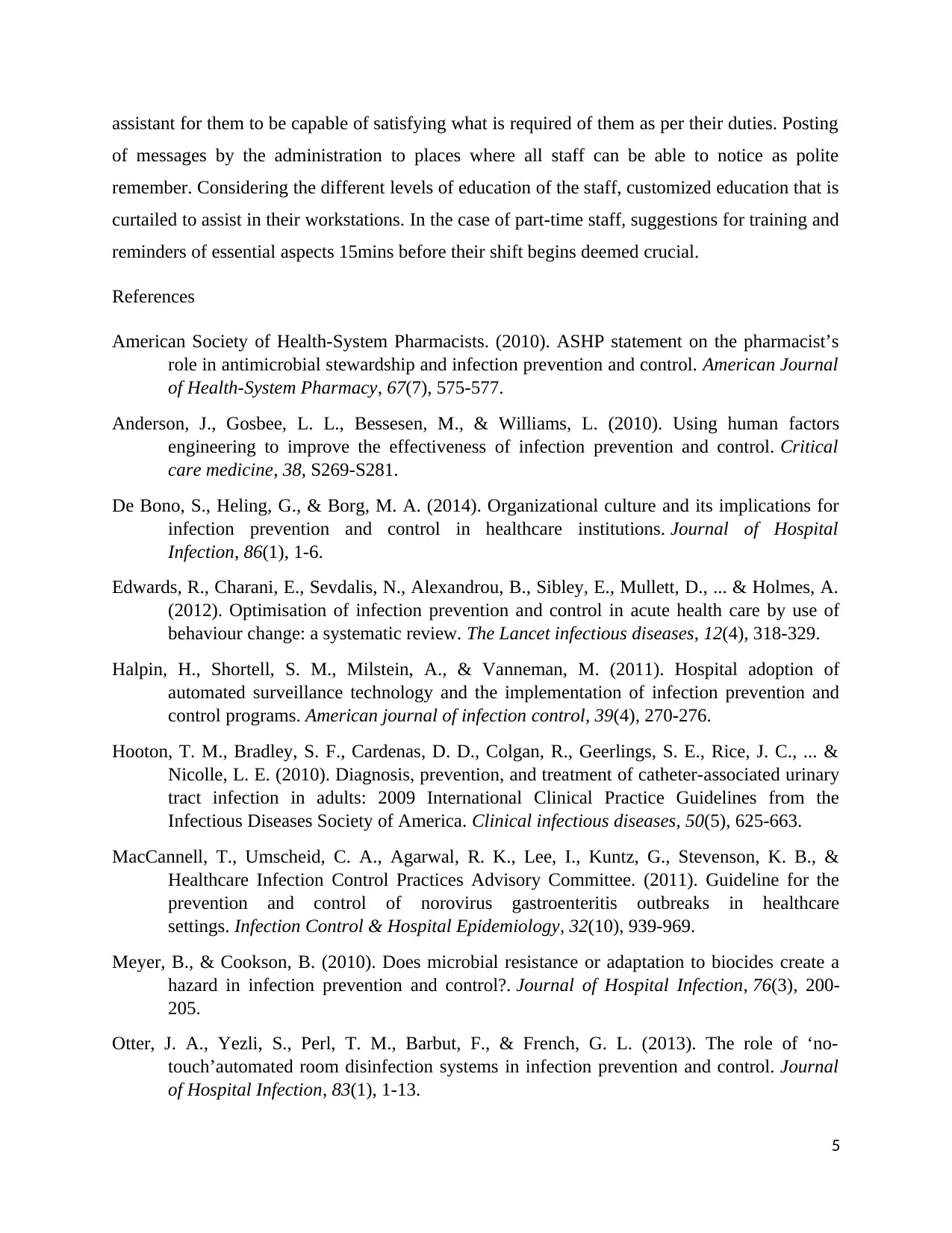
assistant for them to be capable of satisfying what is required of them as per their duties. Posting
of messages by the administration to places where all staff can be able to notice as polite
remember. Considering the different levels of education of the staff, customized education that is
curtailed to assist in their workstations. In the case of part-time staff, suggestions for training and
reminders of essential aspects 15mins before their shift begins deemed crucial.
References
American Society of Health-System Pharmacists. (2010). ASHP statement on the pharmacist’s
role in antimicrobial stewardship and infection prevention and control. American Journal
of Health-System Pharmacy, 67(7), 575-577.
Anderson, J., Gosbee, L. L., Bessesen, M., & Williams, L. (2010). Using human factors
engineering to improve the effectiveness of infection prevention and control. Critical
care medicine, 38, S269-S281.
De Bono, S., Heling, G., & Borg, M. A. (2014). Organizational culture and its implications for
infection prevention and control in healthcare institutions. Journal of Hospital
Infection, 86(1), 1-6.
Edwards, R., Charani, E., Sevdalis, N., Alexandrou, B., Sibley, E., Mullett, D., ... & Holmes, A.
(2012). Optimisation of infection prevention and control in acute health care by use of
behaviour change: a systematic review. The Lancet infectious diseases, 12(4), 318-329.
Halpin, H., Shortell, S. M., Milstein, A., & Vanneman, M. (2011). Hospital adoption of
automated surveillance technology and the implementation of infection prevention and
control programs. American journal of infection control, 39(4), 270-276.
Hooton, T. M., Bradley, S. F., Cardenas, D. D., Colgan, R., Geerlings, S. E., Rice, J. C., ... &
Nicolle, L. E. (2010). Diagnosis, prevention, and treatment of catheter-associated urinary
tract infection in adults: 2009 International Clinical Practice Guidelines from the
Infectious Diseases Society of America. Clinical infectious diseases, 50(5), 625-663.
MacCannell, T., Umscheid, C. A., Agarwal, R. K., Lee, I., Kuntz, G., Stevenson, K. B., &
Healthcare Infection Control Practices Advisory Committee. (2011). Guideline for the
prevention and control of norovirus gastroenteritis outbreaks in healthcare
settings. Infection Control & Hospital Epidemiology, 32(10), 939-969.
Meyer, B., & Cookson, B. (2010). Does microbial resistance or adaptation to biocides create a
hazard in infection prevention and control?. Journal of Hospital Infection, 76(3), 200-
205.
Otter, J. A., Yezli, S., Perl, T. M., Barbut, F., & French, G. L. (2013). The role of ‘no-
touch’automated room disinfection systems in infection prevention and control. Journal
of Hospital Infection, 83(1), 1-13.
5
of messages by the administration to places where all staff can be able to notice as polite
remember. Considering the different levels of education of the staff, customized education that is
curtailed to assist in their workstations. In the case of part-time staff, suggestions for training and
reminders of essential aspects 15mins before their shift begins deemed crucial.
References
American Society of Health-System Pharmacists. (2010). ASHP statement on the pharmacist’s
role in antimicrobial stewardship and infection prevention and control. American Journal
of Health-System Pharmacy, 67(7), 575-577.
Anderson, J., Gosbee, L. L., Bessesen, M., & Williams, L. (2010). Using human factors
engineering to improve the effectiveness of infection prevention and control. Critical
care medicine, 38, S269-S281.
De Bono, S., Heling, G., & Borg, M. A. (2014). Organizational culture and its implications for
infection prevention and control in healthcare institutions. Journal of Hospital
Infection, 86(1), 1-6.
Edwards, R., Charani, E., Sevdalis, N., Alexandrou, B., Sibley, E., Mullett, D., ... & Holmes, A.
(2012). Optimisation of infection prevention and control in acute health care by use of
behaviour change: a systematic review. The Lancet infectious diseases, 12(4), 318-329.
Halpin, H., Shortell, S. M., Milstein, A., & Vanneman, M. (2011). Hospital adoption of
automated surveillance technology and the implementation of infection prevention and
control programs. American journal of infection control, 39(4), 270-276.
Hooton, T. M., Bradley, S. F., Cardenas, D. D., Colgan, R., Geerlings, S. E., Rice, J. C., ... &
Nicolle, L. E. (2010). Diagnosis, prevention, and treatment of catheter-associated urinary
tract infection in adults: 2009 International Clinical Practice Guidelines from the
Infectious Diseases Society of America. Clinical infectious diseases, 50(5), 625-663.
MacCannell, T., Umscheid, C. A., Agarwal, R. K., Lee, I., Kuntz, G., Stevenson, K. B., &
Healthcare Infection Control Practices Advisory Committee. (2011). Guideline for the
prevention and control of norovirus gastroenteritis outbreaks in healthcare
settings. Infection Control & Hospital Epidemiology, 32(10), 939-969.
Meyer, B., & Cookson, B. (2010). Does microbial resistance or adaptation to biocides create a
hazard in infection prevention and control?. Journal of Hospital Infection, 76(3), 200-
205.
Otter, J. A., Yezli, S., Perl, T. M., Barbut, F., & French, G. L. (2013). The role of ‘no-
touch’automated room disinfection systems in infection prevention and control. Journal
of Hospital Infection, 83(1), 1-13.
5
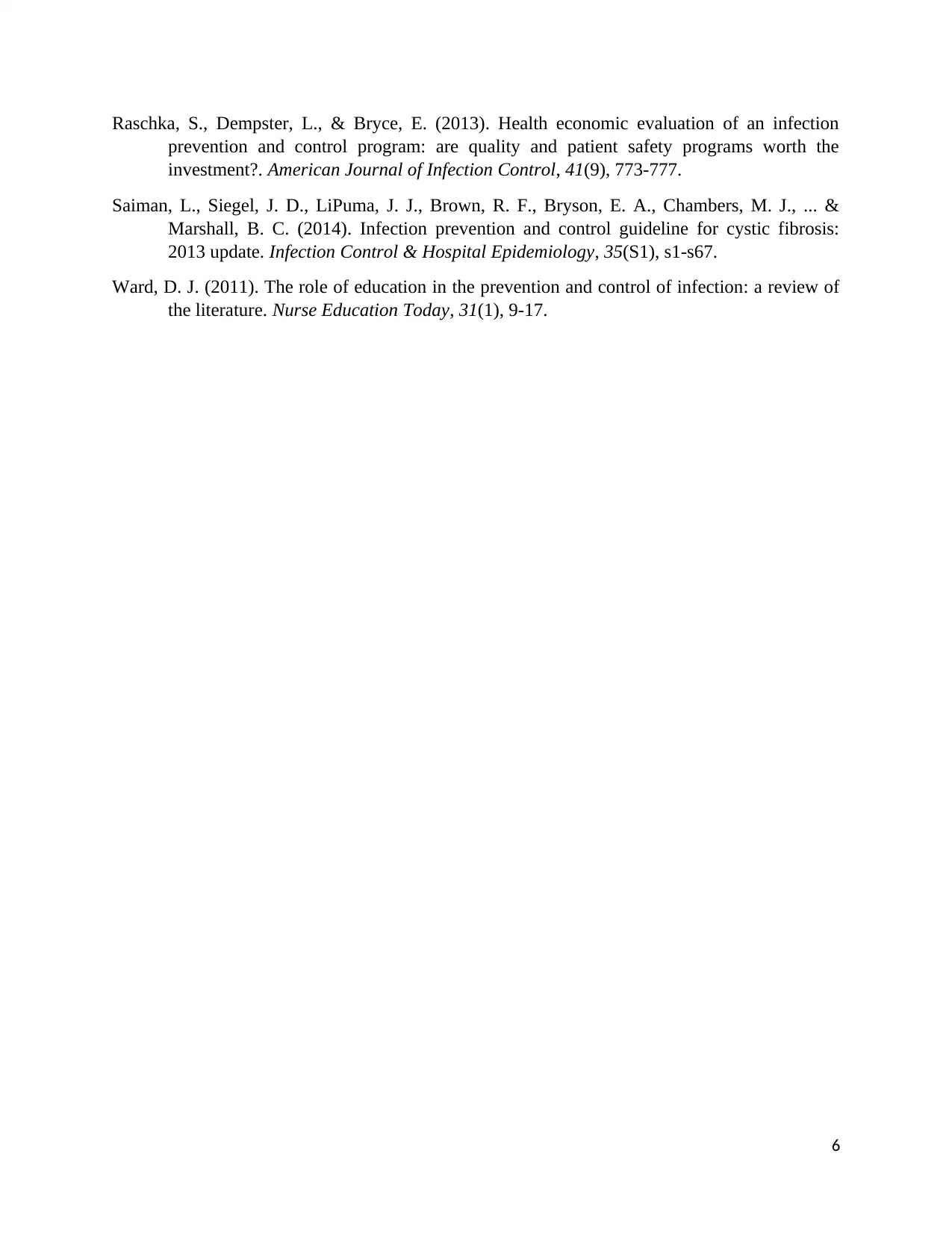
Raschka, S., Dempster, L., & Bryce, E. (2013). Health economic evaluation of an infection
prevention and control program: are quality and patient safety programs worth the
investment?. American Journal of Infection Control, 41(9), 773-777.
Saiman, L., Siegel, J. D., LiPuma, J. J., Brown, R. F., Bryson, E. A., Chambers, M. J., ... &
Marshall, B. C. (2014). Infection prevention and control guideline for cystic fibrosis:
2013 update. Infection Control & Hospital Epidemiology, 35(S1), s1-s67.
Ward, D. J. (2011). The role of education in the prevention and control of infection: a review of
the literature. Nurse Education Today, 31(1), 9-17.
6
prevention and control program: are quality and patient safety programs worth the
investment?. American Journal of Infection Control, 41(9), 773-777.
Saiman, L., Siegel, J. D., LiPuma, J. J., Brown, R. F., Bryson, E. A., Chambers, M. J., ... &
Marshall, B. C. (2014). Infection prevention and control guideline for cystic fibrosis:
2013 update. Infection Control & Hospital Epidemiology, 35(S1), s1-s67.
Ward, D. J. (2011). The role of education in the prevention and control of infection: a review of
the literature. Nurse Education Today, 31(1), 9-17.
6
⊘ This is a preview!⊘
Do you want full access?
Subscribe today to unlock all pages.

Trusted by 1+ million students worldwide
1 out of 6